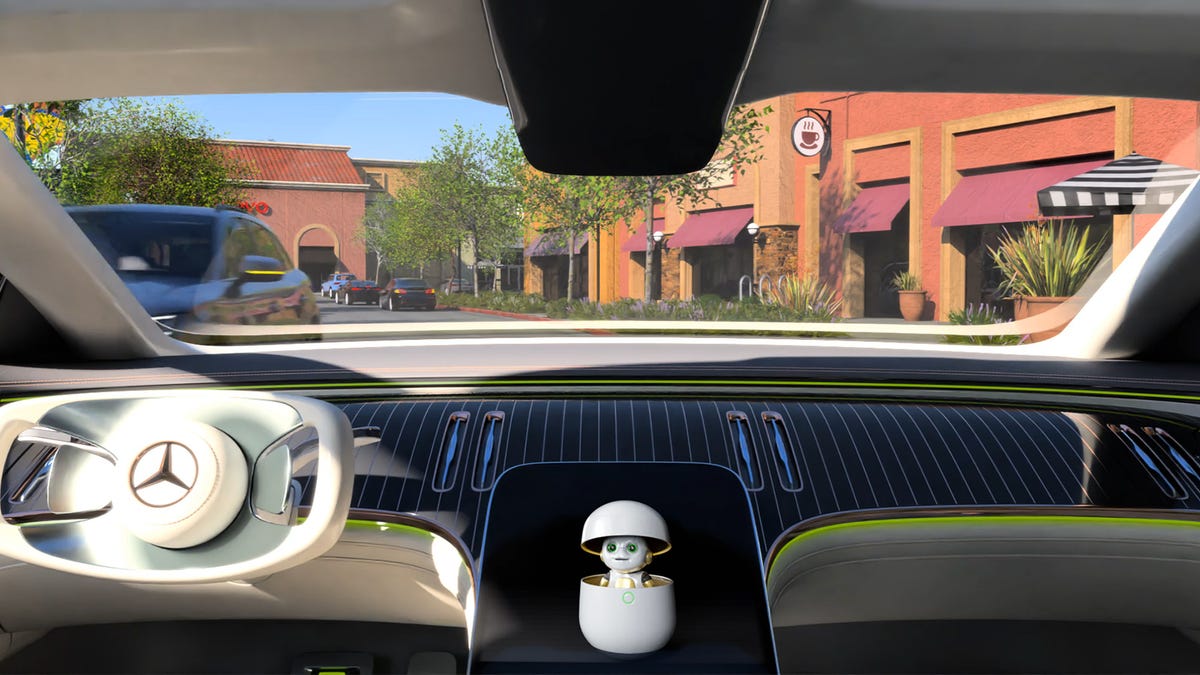Hey, Nvidia, park my car: Drive Concierge and Chauffeur AI tech announced
Announced at GTC this week, Nvidia's new AI technology is sort of like Siri if you could ask her to valet your car.

Drive Concierge is a smart digital assistant that can take the wheel when you need it to.
With its Orin automotive system-on-a-chip arriving in vehicles soon, Nvidia turns its attention to practical applications of its future autonomous vehicle tech. The semiconductor giant announced two new AI-driven software technologies -- Nvidia Drive Concierge and Drive Chauffeur -- at its GTC conference on Tuesday, alongside news that the Drive Hyperion 8 autonomous platform is now ready for production vehicles.
Nvidia Drive Concierge
Nvidia Drive Concierge is an AI-driven software assistant that combines conversational voice assistance with driver monitoring and autonomous parking tech. It's sort of like asking Siri to valet your car. Drive Concierge can field simple and complex natural voice commands -- from initiating a phone call to booking reservations -- and is personalized to each passenger's voice, giving everyone onboard their own virtual assistant. The assistant can act proactively to, for example, alert the user if the cabin cameras detect you've left your bag or purse in the backseat. While driving, those same cameras monitor the driver's attention level to encourage a drowsy driver to take a break or nudge a distracted driver's eyes back to the road. In the dashboard, drivers will interact with a visual representation of the digital assistant built using ray-traced graphics and Nvidia's newly announced Omniverse Avatar technology.
However, Drive Concierge's coolest party trick is its integration with the Nvidia Drive AV autonomous driving tech, providing on-demand valet parking. Drivers will be able to activate the feature and be dropped curbside while the car navigates itself to a nearby parking spot.
Nvidia claims the system is smart enough to consider factors such as loading zones, accessible spaces, fire hydrants, street sweeping times and obstructions such as concrete pillars or shopping carts. It can handle parallel, perpendicular and angled parking. Drivers will also be able to summon the car for pickup when it's time to hit the road again.
The Drive Hyperion 8 platform includes 12 cameras, 12 ultrasonic sensors, nine radar sensors and a forward-looking lidar scanner.
Nvidia Drive Chauffeur and Hyperion 8
Building further on the Nvidia Drive AV tech is the Drive Chauffeur AI-assisted software for autonomous driving. Nvidia claims that Drive Chauffeur is capable of address-to-address autonomous driving and can handle both highway and urban traffic conditions. For drivers who would rather drive themselves, the same Drive AV tech that powers the Chauffeur can also be used to power active driver-assistance systems. Nvidia says that this tech "relieves the human driver from the burden of controlling the vehicle and monitoring the surrounding environment at all times," allowing them to focus their time and energy elsewhere.
Drive Chauffeur integrates tightly with Concierge, displaying a 3D visualization of the road onscreen when operating autonomously. Nvidia calls this a Confidence View and thinks it helps the driver build trust with the autonomous driving system. The technologies behind both Drive Concierge and Chauffeur are powered by the Nvidia Drive Hyperion 8 architecture and sensor suite for full self-driving systems.
Hyperion starts with a pair of Nvidia Drive Orin SoCs that, together, provide the redundancy and safety required for autonomous driving functions. If one chip malfunctions or experiences, say, a cosmic ray-induced computational hiccup, its twin will be there to check its work or take over. Orin is purpose-built for the types of simultaneous applications and deep neural networks required for the higher levels of autonomous driving, with each SoC capable of 254 trillion operations per second.
Nvidia's Drive Orin SoC is the backbone of the new AI tech and the Hyperion 8 platform.
Beyond the SoCs, Hyperion 8 features a standardized suite of sensors from Nvidia's partners Luminar, Hella, Continental, Sony and Valeo. In total, there are 12 cameras, nine radar sensors, 12 ultrasonic sensors and a single forward-looking lidar scanner that, according to Nvidia, have been "calibrated precisely for 4D data collection." The sensors feed into the Orin twins where the Nvidia DriveWorks Sensor Abstraction Layer forms a model of the environment that gets fed into the Nvidia Drive AV software where the AI makes decisions about negotiating the road.
Hyperion 8 is designed to be a modular, production-ready autonomous platform, so vehicle designers can pick and choose individual technologies to implement, whether that be Level 3 driving, driverless parking or just AI-enhanced dashboard applications, or going all-in on an Nvidia-powered car. It's also scalable, so automakers who adopt the tech will be able to seamlessly transition to Nvidia Drive Atlan SoCs when those come online in 2025.
Nvidia says that Drive Hyperion 8 is available now for 2024 model year cars, but we're not sure what vehicles specifically. Previously, Volvo and Mercedes-Benz announced partnerships to use Nvidia Drive tech in future cars.

